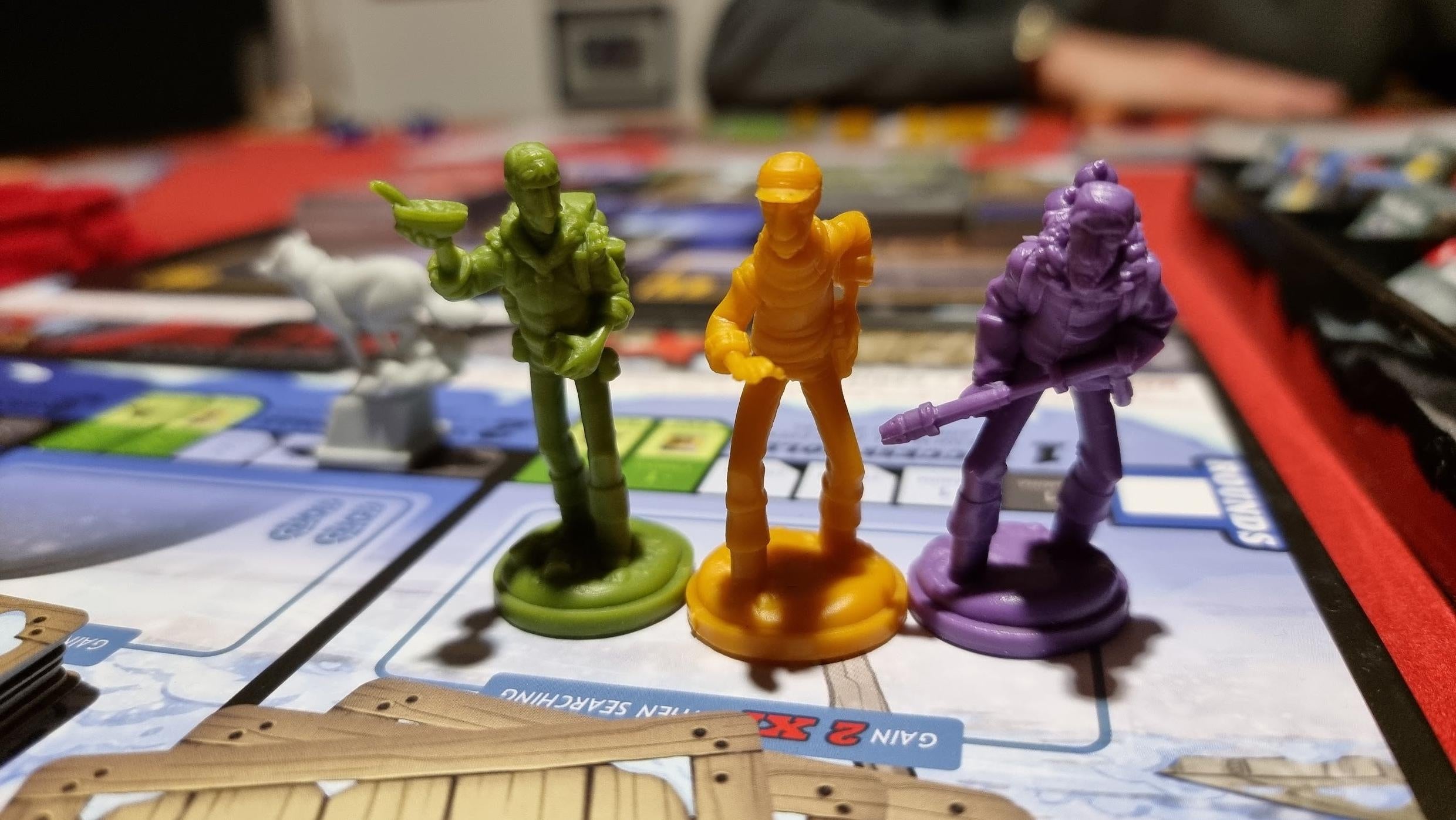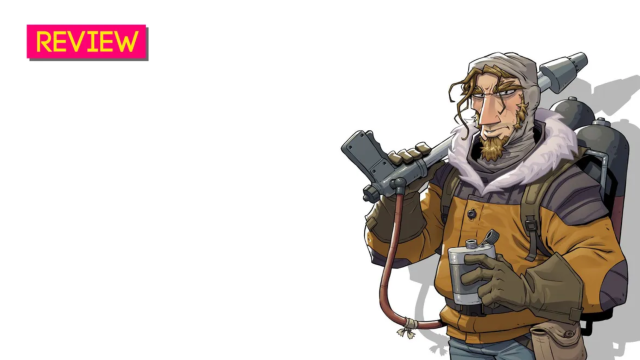You’ve seen The Thing, right? Well this is the board game adaptation.
Very serious fans of the movie will already know that of course, since Who Goes There? is the name of John W. Campbell Jr.’s original 1938 novel that the film is based on, but I just wanted to get that clear up top, since a working knowledge of either is going to help going forwards here.
Who Goes There? (the game), bearing the book’s name but with loads of visual cues lifted straight from John Carpenter’s 1982 movie, was originally released in 2018 and was pretty well-received, albeit with a few fairly common complaints. It returned a couple of years later in 2020 with a Second Edition which, like a video game in need of some post-launch care, sought to address some of the original version’s issues.
I never played that first edition, so I’m not going to be able to compare it to this. I’m not sure I’ll ever want to play it, though, since even this newer, revised version has some glaring issues that I would have thought would be caught and ironed out in a re-release (And I’ll get to those later).
So what’s the game actually like? It’s official summary does an excellent job of getting the gist across:
Who Goes There? is a cooperative game of growing paranoia. At the beginning of the game, all players are human and there is no reason not to trust each other completely, but as the temperature drops and mistakes are made, players start doubting everything and everyone around them.
You must build, trade, and upgrade to prepare yourself for the Antarctic Terrain, rabid dog attacks, crazed madmen…and most importantly, the alien entity that is now loose in the camp. Everything you build and upgrade has one purpose…keeping you alive and human! During the entire game, you will want to trade with other players and help each other build stronger weapons and better equipment, while also passing food and med kits around. Although, make sure your trust them, since trade is a huge opportunity for The Thing.
Staying inside may keep you from freezing to Death, but it won’t help you or your fellow humans win. The only way to secure victory is by venturing out of the camp! The problem with that is, being away from camp is the number one way to come across The Thing…leaving you vulnerable and exposed to infection. Whether fixing the boiler, repairing the door, or fighting the frigid temperatures outside, you will all need one another to survive. But trust is a hard thing to come by when you must be wary of…Who Goes There?
Basically then it’s a game where everyone is working together and trusts each other to try and overcome a perilous situation, until it’s not, and becomes instead a game where everyone suspects everyone else is secretly a murderous alien lifeform disguised by freezing human flesh.
The goal is for every player to try and survive a set number of rounds (normally 15) and then, at the end of that, get onboard a helicopter and get the hell out of there. Who wins, though, depends on who exactly gets onboard that chopper, with human players trying to keep infected alien monsters off, while anyone infected is trying to pretend they’re not infected and smiling and getting onto the helicopter alongside the humans like everything was totally fine. There’s then a bunch of depressing maths and luck to work out the winner, and I’m not going to talk about that yet because it gets me down, and I want to talk about all the good stuff first.
Everything up to Who Goes There?’s endgame, which is really 98% of your time with it, is fantastic. It’s a wonderful adaptation of The Thing, really nailing both the desperation of the source as survival becomes increasingly desperate, as well as the mounting suspicion everyone is feeling as it becomes clear there’s an alien potentially hiding under anyone’s skin.
Conditions are so brutal that it’s often tough just surviving in the first place, with dog attacks, terrible weather and exploding boilers making each round more dangerous than the last. Throw in the fact you need to head outside all the time to get stuff you need for the helicopter escape, and then be secretly monitoring and worrying about everyone else at the table at all times, and things get pretty stressful the closer you get to the end!
The whole thing is all very tense, and the fact you’re all having to work together while at the same time trying to not work together — cooperating is essential for survival, but cooperating is also the easiest way to alien players to infect humans — really makes the experience feel like you’re playing through the second half of the movie, juggling survival with a descent into madness.

It’s such an enormous shame, then, that when the end finally comes, it sucks. If players are able to survive until all turns are over, a helicopter comes to rescue you, and it’s time for the table — you can play with 3-6 players, but you really want that to be 4-6 — to make some hard decisions. The group leader, who throughout the game has determined the turn order, can be voted out of their position if other players suspect they’re The Thing, and whoever ends up in the job is responsible for choosing who gets to go on the chopper and who stays behind to die.
Everybody making it into the chopper then adds up how many helicopter points they picked up throughout the game by braving the weather and going outside, and finally rolls a special dice to generate more helicopter points and sees if they beat a required points threshold required for victory. There’s a catch, though: if any infected made it into the chopper, you have to deduct their points from the total.
To win the humans need to beat that score requirement, even if they…let The Thing (or multiple Things!) onto the chopper with them? And for the infected to win, they need to have got at least one alien into the helicopter and see the humans not get the required score.
It’s an incredibly deflating way to end an otherwise great game for two reasons. Firstly, it’s difficult getting an idea on who is infected simply through gameplay (unlike other similar games, like Battlestar Galactica), so the vote at the end often felt like it was simply guessing, rather than the result of any kind of longterm detective work.
And secondly, a huge part of meeting your required points total comes from a dice roll! I played this game twice, and the first time the humans lost because an infected made it onto the chopper rolling a 6 and I, the human, rolled a 1. It hadn’t mattered that over the past two hours I’d frozen my arse off getting three bonus helicopter points, fighting off aliens and suffering frostbite, because a single dice roll had negated the whole thing.
This is bullshit! Taking such a significant part of the player’s agency out of their own hands at the end of hours of gaming sucks. Throw in the weirdness of being able to win despite letting aliens onto the chopper with you, and the arbitrary nature of having to consult a flowchart to see if you’d won or not and Who Goes There? really does work overtime to slice any fun or satisfaction out of its ending.
I still think it’s a very cool co-op survival game, and the parts where everyone is working together — which is the vast majority of your time spent at the table with Who Goes There? — are really unique and enjoyable. Just know this a game for folks who are into the journey a lot more than the destination.

Leave a Reply